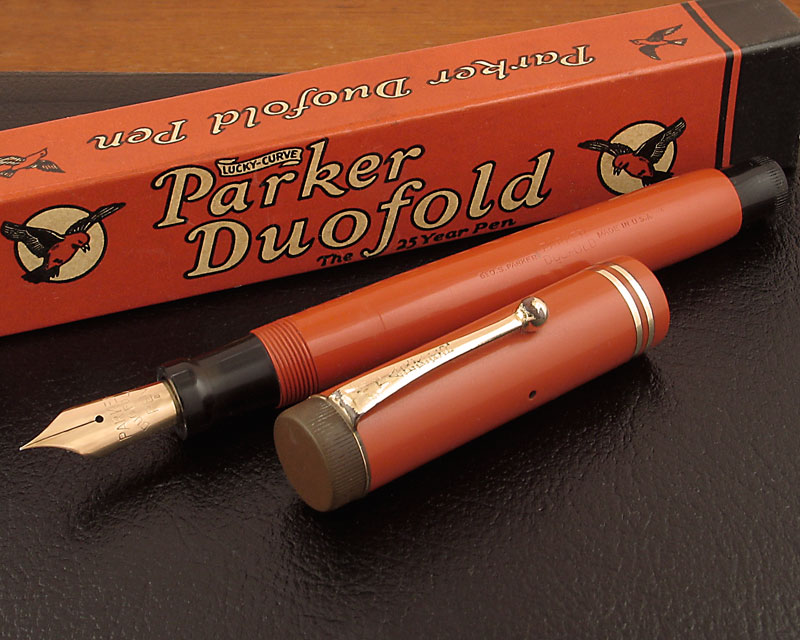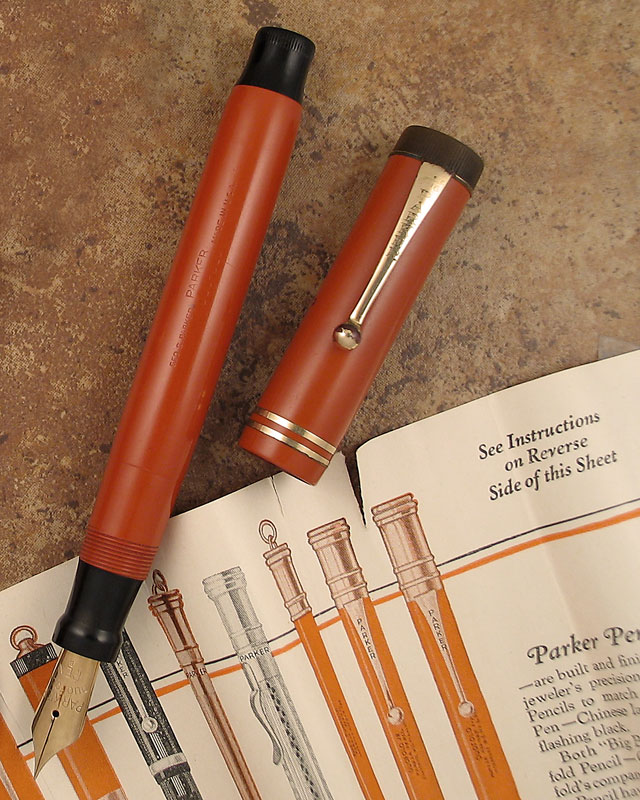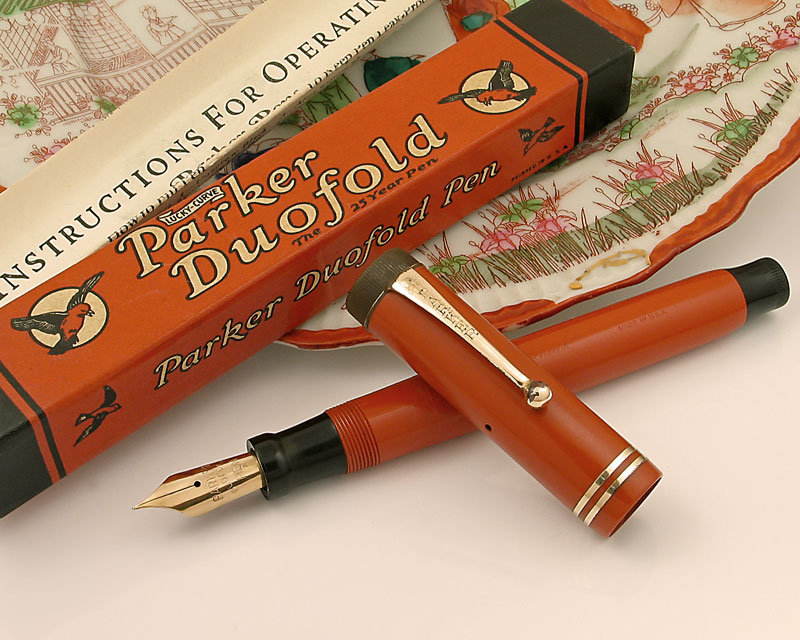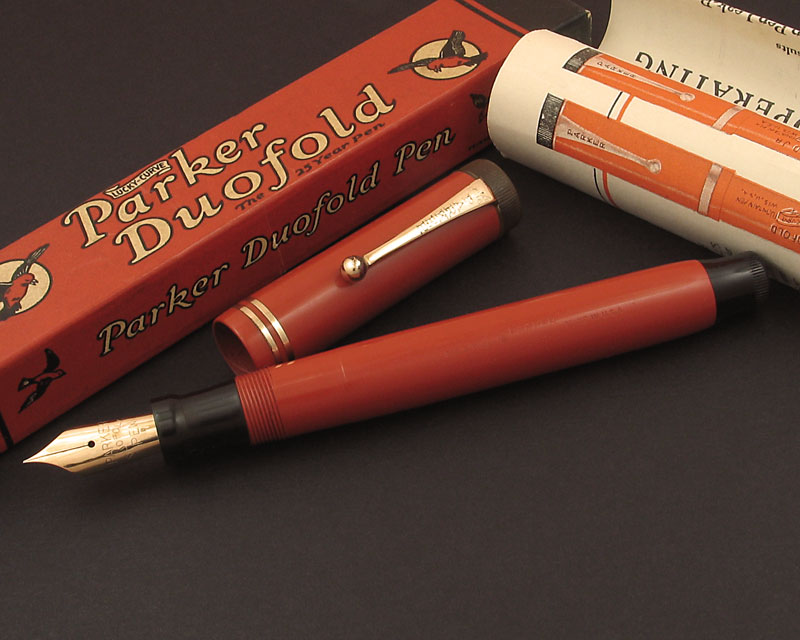PenHero 365: Parker Duofold Over-Size Lacquer Red
by Jim Mamoulides, January 25, 2010

Parker Duofold Over-Size Lacquer Red fountain pen open
The Parker Duofold "Big Red" is one of the quintessential collectible fountain pens. Credit for creating this landmark pen goes to Lewis M. Tebbel, a Parker District Sales Manager located in Spokane, Washington. According to David Sheppard and Dan Zazove's definitive book, Parker Duofold, Tebbel had a business trip to the Parker factory in Janesville, Wisconsin in early 1921 and while there had one of the machinists in the factory make him a No 26 model button filler pen in red hard rubber. The pen would have the same black cap top and button covering blind cap, giving it a black tipped look. This was a gutsy call as Parker had lost a lot of money buying back defective slip cap Red Giants due to cracking in the hard rubber, likely due to excessive red pigmentation.

Parker Duofold Over-Size Lacquer Red fountain pen open showing nib and cap detail
Tebbel took the pen back to Washington state and soon started submitting orders for the new pen, which he started calling the "Duofold." Tebbel was finding success with the pen in the field and generating interest, so he asked to have the pen be made in quantity with a retail price of $7.00, $1.00 more than the identical No 26 model that had had copied. Harold Blackman, the National Sales Manager rejected the idea, but Tebbel convinced Kenneth Parker that color was the future for pens, and that the Duofold was the right pen for Parker.

Parker Duofold Over-Size Lacquer Red fountain pen open
Parker began advertising the new Duofold as a "Red Brown" pen in November, 1921. The Duofold was positioned as a top of the line pen, selling for $7.00, when the typical black hard rubber pen sold for about $3.00. Parker next called the color Pompeian Brown in December, 1921 advertisements. The 1922 catalog listed the color as Chinese Red, probably a hat tip to George Parker's fascination with the Orient, and the name morphed into Chinese Lacquer Red, and simply Lacquer Red over time. In 1923, Parker added a single, wide cap band, or "girdle" to the pen. Parker changed the material to Permanite in 1925, replacing the more brittle and difficult to manufacture red hard rubber with a new DuPont plastic. In 1928, Parker changed the cap band from one single wide band to two narrow bands. In 1929, Parker redesigned the Duofold line to a streamlined shape, and the Lacquer Red model no longer looked like a red No 26.

Parker Duofold Over-Size Lacquer Red fountain pen open
Parker offered the Duofold with six firm nib types, extra fine, fine, medium, broad, stub, and oblique. These were essentially Parker number 6 nibs with the Duofold stamping. These nibs write wonderfully smoothly, but are as firm as a ten penny nail. Tebbel's first pen had a manifold nib, and Parker probably kept that line of thinking when offering a 25 year warranty on the pen, as flexible nibs are prone to cracking and breakage with misuse.

Parker Duofold Over-Size Lacquer Red fountain pen nib detail
This Parker Duofold Over-Size Lacquer Red hails from 1928 and the original box and instructions are actually from 1925. I keep them together as they fit, but if I decide I need a 1925 Lacquer Red Duofold, this one may have to move out.
This Parker Duofold Over-Size Lacquer Red is a large, yet lighter weight pen, weighing 0.8 ounce and being 5 3/8 inches long with the cap on and a huge 6 3/4 inches with the cap posted on the end of the barrel. Duofold's post perfectly, but take care not to jam the cap on as the caps are prone to cracking. These pens usually show brassing on the clip ball, as seen here, and on the high points of the clip and cap bands. The black hard rubber cap op and blind cap both can show browning and fading, as well as loss of the coin edge chasing to the sides.

Parker Duofold Over-Size Lacquer Red fountain pen open
Parker Duofold's have an uncommon button filling system, where a button at the base of the barrel (under the blind cap) is pressed, bending a pressure bar inside the barrel, which squeezes the ink sac. The pen is held with one hand with the nib in the ink and the button is pressed with the thumb. It's actually pretty easy, from a user's point of view, just don't lose the blind cap! Wipe the nib and section and you are ready to write. In spite of the huge barrel, I have found that Duofold's don't hold a lot more ink than smaller sac pens, but you will get just a little more mileage.
The extra fine nib on this Duofold is a smooth nail and writes a wet hairline on the page. Such a nib will sip ink, so a lot of writing could be done with this nib.
Parker Duofold "flat tops" were made for nearly ten years, and Lacquer Red color pens are not difficult to find, with user grade pens not being overly pricey. This would be one of the must have pens for a definitive collection. You can read more about the Parker Duofold flat-top pens in this article: Parker Duofold Flat-Top Pens 1921-1929.
Discuss / Recommend what you read on PenHero.com
Follow us on Twitter: PenHero
Add a link to PenHero.com on your blog:
(Copy & paste code)
Please only use the photo provided. Use of other photos requires permission.
The provided link photo will change as we update the site.
Comments on this article may be sent
to the author, Jim Mamoulides
PenHero.com Bibliography
